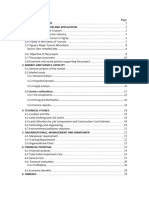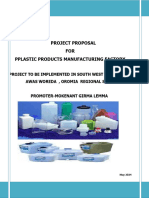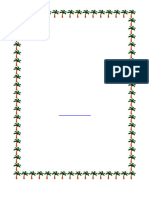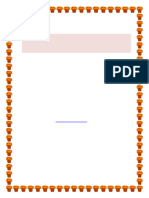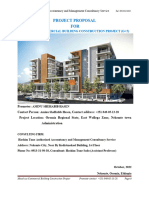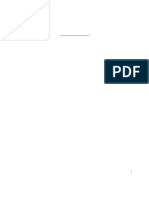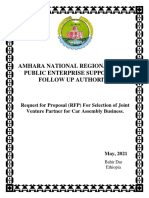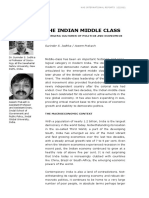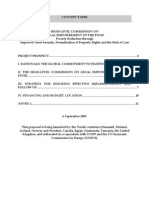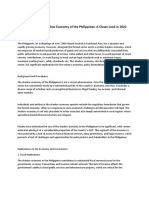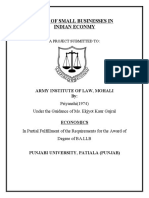Project Proposal FOR High Tech Plastic Product
Project Proposal FOR High Tech Plastic Product
Uploaded by
Tesfaye DegefaCopyright:
Available Formats
Project Proposal FOR High Tech Plastic Product
Project Proposal FOR High Tech Plastic Product
Uploaded by
Tesfaye DegefaOriginal Title
Copyright
Available Formats
Share this document
Did you find this document useful?
Is this content inappropriate?
Copyright:
Available Formats
Project Proposal FOR High Tech Plastic Product
Project Proposal FOR High Tech Plastic Product
Uploaded by
Tesfaye DegefaCopyright:
Available Formats
PROJECT PROPOSAL
FOR
HIGH TECH PLASTIC PRODUCT
(HIGH PRESSURE FACILITIES, WATER SUPPLY AND SEWAGE,
PIPES, FITTINGS, INDUSTRIALS PACKING CONTAINERS, PVC,
PPR AND HDPE AND OTHERS RELATED)
PROJECT TO BE IMPLEMENTED IN ADAMI TULU
DISTRICT, EAST SHOA ZONE, OROMIA REGION STATE
PROMOTER’S- ARFASA GENERAL TRADING PLC
NOV, 2020 E.C
[PROMOTER’S: - ARFASA GENERAL TRADING PLC] USER
HIGH TECH PLASTIC PRODUCT
[2020]
FINFINE, ETHIOPIA
PROMOTER’S: - ARFASA GENERAL TRADING PLC 2
TABLE OF CONTENTS
TABLE OF CONTENTS...............................................................................................................2
EXECUTIVE SUMMARY.............................................................................................................4
1. INTRODUCTION...................................................................................................................5
1.1. Project Justification......................................................................................................................5
1.2. Objective of the Project...............................................................................................................7
1.3. The Economic Significance of the Project....................................................................................7
1.4. Location, infrastructure and land...............................................................................................16
1.5. Land Use Plan.....................................................................................................................17
2. MARKET STUDY AND PLANT CAPACITY....................................................................18
2.1. Market Study.............................................................................................................................18
2.1.1. Fast GDP Growth............................................................................................................18
2.1.2. Demand for PVC Pipe and Conduit and Fitting...........................................................21
2.1.3. Supply of PVC Pipe........................................................................................................24
2.1.4. Demand and Supply Analysis........................................................................................31
2.1.5. Global Market of UPVC..................................................................................................32
2.1.5.1. UPVC Pipes Manufacturing Industry, Global Scenario..........................................33
2.2. PLANT CAPACITY AND PRODUCTION PROGRAM.......................................................................34
2.2.1. Plant Capacity..................................................................................................................34
2.2.2. Production program........................................................................................................34
2.3. PRICING AND DISTRIBUTION......................................................................................................35
3. TECHNOLOGY, ENGINEERING PRODUCTS NATURE AND USE..........................35
3.1. Product Nature and Uses...........................................................................................................35
3.2. Raw Materials and Inputs...............................................................................................................36
3.3. Production Process....................................................................................................................37
3.3.1. General Production Process and Technology.............................................................37
3.3.2. Detail Production Process..............................................................................................38
3.4. Machinery and Equipment Requirement...................................................................................41
3.5. Civil Engineer Building and Civil Works......................................................................................42
3.6. Utilities.......................................................................................................................................43
[PROMOTER’S: - ARFASA GENERAL TRADING PLC] USER
HIGH TECH PLASTIC PRODUCT
[2020]
4. OGANIZATION, MANAGEMENT AND MANPOWER...................................................44
4.1. Organization and Management.................................................................................................44
4.2. Man Power................................................................................................................................44
4.3. Organizational Structure............................................................................................................44
5. FINANCIAL REQUIRMENT AND ANALYSIS.................................................................48
5.1. Total Initial Investment Cost......................................................................................................48
5.1.1. Fixed Investment...................................................................................................................49
5.1.2. Initial Working Capital............................................................................................................51
5.1.3. Pre -Service Expense..............................................................................................................51
5.2. Annual Production Cost at Full Capacity....................................................................................52
5.3. Financial Analysis and Statements.............................................................................................55
5.3.1. Underlying Assumption...................................................................................................55
5.3.2. Source of Fund................................................................................................................55
5.3.3. Loan Repayment Schedule............................................................................................56
5.3.4. Depreciation Schedule...................................................................................................56
5.3.5. Revenue Projection.........................................................................................................57
5.3.6. Balance Sheet.................................................................................................................57
5.3.7. Income/Loss Statement..................................................................................................58
5.3.8. Profitability........................................................................................................................59
5.3.9. Pay-Back Period..............................................................................................................59
6. ENVIRONMENTAL IMPACT OF THE PROJECT..........................................................60
6.1. Environmental Impact Assessment Of The Project....................................................................60
6.2. The Environmental Impact of Vinyl Chloride.............................................................................60
PROMOTER’S: - ARFASA GENERAL TRADING PLC 4
EXECUTIVE SUMMARY
1. Project Title –High Tech Plastic Product
High Pressure Facilities,
Water Supply and Sewage,
Pipes,
Fittings,
Industrials Packing Containers,
PVC,
PPR
HDPE and Others Related)
1.1. Promoter – ARFASA GENERAL TRADING PLC
1.2. Status: - New
1.3. Nationality: - Ethiopian
2. Project Location: - Oromia Regional State
East Shoa Zone
Adami Tulu District
3. Premises Land Area: -
3.1. Premises Requirement: - 12 Hek
4. Total Capital: - 1,000,000,000 Ethiopian Birr
Total Capital
4.1. Fixed Capital = 340,600,000 birr
4.2. Working Capital = 555,229,224 birr
4.3. Contingency (Lump sum) = 104,170,776 birr
Source Fund
4.4. Own Equity (30%) = 300,000,000 birr
4.5. Bank loan (70%) = 700,000,000 birr
[PROMOTER’S: - ARFASA GENERAL TRADING PLC] USER
HIGH TECH PLASTIC PRODUCT
[2020]
5. Planned Employment of the creation of the project
The total manpower required for the plant will be 3,000 employees
5.1. Permanent Worker: - 1,000
Skilled and Unskilled
5.2. On Temporary Basic: - 2,000
Skilled and Unskilled
6. Benefits of the factory For the Region/ Country: -
Produce and supply of quality plastic and plastic recycling processing Products, add value to
the economy, Source of Revenue, Employment opportunity, Save Foreign currency, Benefit for
the Local Community, Stimulate the Local Economy and technology transfer
PROMOTER’S: - ARFASA GENERAL TRADING PLC 6
HIGH TECH PLASTIC PRODUCT
[2020]
1. INTRODUCTION
In dynamic economic environment, like the one currently exists in Ethiopia, the
development of industry and supportive manufacturing sector has a great role to make
the overall economic growth to be persistent.
The government of Ethiopia has a conducive investment polices and guidelines that
promote the private sectors involvement in the economic development through the
various investment and business endeavors.
In this regard, the owner of the envisioned factory planned to invest in adami tulu
district, east shoa zone of Oromia region state and carried out this pre-project study to
check the market, technical and financial feasibility of this project. The result of the
study is very sound and promising for the owner to start the project in this area.
The promoter is very determined to commence the project. Hence, he expects to get the
required support from the regional and local governments to make the project
operational.
1.1. Project Justification
High Tech Plastic Product (High Pressure Facilities, Water Supply and Sewage, Pipes,
Fittings, Industrials Packing Containers, PVC, PPR and HDPE and Others Related)
are made up of long chain molecules called polymers. Various types of polymers can be
made from hydrocarbons derived from coal, natural gas, oil and organic oils which are
transformed into materials with desirable properties. Plastics that can be readily
recycled are Thermoplastics which means they will soften when heated. Thermosetting
Plastics harden when heated, are often used in electrical applications and are not
suitable for recycling. Thermoplastics are light, durable, modulable, hygienic and
economic, making them suitable for a wide variety of applications including food and
product packaging, car manufacturing, agriculture and housing products.
PROMOTER’S: - ARFASA GENERAL TRADING PLC 7
HIGH TECH PLASTIC PRODUCT
[2020]
Thermoplastics can be repeatedly reformed into new products and are the focus of this
technical brief. Ethiopia has a great economic potential in Africa. The current dynamic
economic growth in all sectors supports the idea to become a great nation. Agriculture
is the backbone of the economy. High improvement in terms of productivity and
efficiency of this sector will strongly support the development of other sectors (in
backward and forward linkages).
In line with the above facts, the government of Ethiopia has implementing the five years
Growth and Transformation Plan (2010/11-2012/15) that aimed to achieve wider
development spectrum in all sectors with a special emphasis to agricultural
development that will realize the formation of industrialized and middle income earned.
In this plan, crop production and productivity, irrigation and improved water use,
technology multiplication, food security and supply and distribution are among the main
strategy for agriculture and rural development strategies.
Regarding infrastructure development, construction, education, private sector role in the
economy and environment the plan has good strategies to achieve the goal of
industrialization.
To all the above facts the parallel growth in complementary (supportive) sectors of the
economy is vital to sustain it. In relation to this, the owner of the envisioned factory
interested to engage in the sector that has government development focus apart from
huge market potentials.
Therefore, manufacturing of PVC based irrigation pipe, water supply, sewerage pipes
and conduits are taken as a promising business by the owner.
PROMOTER’S: - ARFASA GENERAL TRADING PLC 8
HIGH TECH PLASTIC PRODUCT
[2020]
Moreover, these days, the PVC based materials are widely used in agriculture and
construction sector especially the pipes. The main reasons behind the need of these
pipes are its durability, beautiful, easy to assemble tough, insulated, long lasting, inert,
resistance (UV rays, Hit, Pests, rats, water and moisture) and have a good variety of
models with reasonable price, which make it more popular around the world.
1.2. Objective of the Project
The main objective of this factory is to manufacture, cost effective, market oriented,
client based and quality recycling plastic , irrigation pipe, conduit, fittings and other pipe
accessories for local market and international market.
1.3. The Economic Significance of the Project
The envisaged project deemed to contribute to the economic development of the nation
in general and the region in specific with following ways:
1.3.1. Value Add
In the production of PVC products from virgin resin and recycling wastage PVC as raw
materials, the project will add value in the PVC industry.
1.3.2. Contribute to the Nation’s Development
By supplying customer oriented, high quality and cost effective PVC materials it will
satisfy the demand for different purposes like building construction, agriculture, supply
and sewerages of the citizens in particular and the nation in general.
1.3.3. Source of Revenue
PROMOTER’S: - ARFASA GENERAL TRADING PLC 9
HIGH TECH PLASTIC PRODUCT
[2020]
As public policy of any nation, the government collects different forms of taxes from
different business organizations and individuals. Among the different forms of taxes,
business income taxes, payroll tax and VAT are collected from undertaking business
activities. Therefore, the project will serve as sources of revenue for both the region and
nation as a whole.
1.3.4. Employment opportunity
One of the problems that our country faced is unemployment. Therefore, the current
objective of the government is working on tackling the problem of unemployment and
fostering the development process either through creating self employment or
employment in other organization. Hence, this project will hire 3,000 citizens.
1.3.5. Save/Generate the Country Foreign Exchange
All types of the envisioned products (Produced by the project) are mostly imported from
abroad. By producing in Ethiopia, the factory will save the foreign currency of the nation.
By minimizing the market demand and supply gab for these products, the factory will
help to reduce the nation’s foreign exchange cost to import these products. This will
save the foreign exchange resource of the nation.
Moreover, the nation can generate foreign currency when the factory start exports these
products to international market.
1.3.6. Benefit for The Local Community
PROMOTER’S: - ARFASA GENERAL TRADING PLC 10
HIGH TECH PLASTIC PRODUCT
[2020]
As a corporate responsibility the company will engage in different development
activities on the surrounding areas. This will better worse the community and contribute
for the development of the nation.
1.3.7. Environmental benefits
Plastics have their impact on the environment through all stages of their existence from
manufacture, to utilization and disposal. Manufacturing requires significant quantities of
fossil fuels, a non-renewable resource. Burning of plastics releases smoke which
contaminates the environment. The smoke contains small particulates, hazardous
substances and greenhouse gases.
The disposal of plastics products also contributes significantly to their environmental
impact. Most plastics are not biodegradable and can persist in the environment for
many years. Plastics can cause blockage of drainage and sewage systems resulting in
water logging, flooding and spread of water born diseases. With more and more plastics
products, particularly packaging, being disposed of soon after their purchase, the landfill
space required by plastics waste
is a growing concern. The factory uses both virgin resins and recycling of wastage PVC
materials, the factory will benefit the region as well as the region in environmental
conservation.
1.3.8. Collection of waste plastic
PROMOTER’S: - ARFASA GENERAL TRADING PLC 11
HIGH TECH PLASTIC PRODUCT
[2020]
An important first step in starting a plastic recycling business is setting up a collection
system of waste plastic. A constant supply of raw material to the factory is of utmost
importance for the existence of the business. Collection of waste plastic may already
happen through the activities of scavengers, middlemen and traders. It is possible to
integrate in this system by letting them know that the factory is willing to buy plastic
waste material. Another option is to cooperate with the municipality to get involved in
collection schemes accompanied with a public awareness campaign. In this way the
public can be informed about the advantages of plastic recycling.
PROMOTER’S: - ARFASA GENERAL TRADING PLC 12
HIGH TECH PLASTIC PRODUCT
[2020]
PROMOTER’S: - ARFASA GENERAL TRADING PLC 13
HIGH TECH PLASTIC PRODUCT
[2020]
PROMOTER’S: - ARFASA GENERAL TRADING PLC 14
HIGH TECH PLASTIC PRODUCT
[2020]
Storage
The plastic recycling enterprise needs quite a large storage space in order to store all
collected waste items, processed materials and finessed products. Plastic waste items,
especially bottles, have a large volume and therefore a large storage place is
necessary.
Sorting and identification
Plastics sorting operations may be carried out manually or automatically using
appropriate means of identification. The more accurate and efficient the means of
identification, sorting and separation, the better is the quality of the recovered product
obtained. Best suited for sorting plastics in developing countries are those technologies
that make extensive use of the (comparative) advantage of cheap labour. The
secondary raw material obtained by hand sorting is of high quality and offers an
excellent basis for producing high quality products by small and medium scale industry
(Vest, 2000).
To aid in identification, it is now common for plastic containers to have a polymer
identification code (see table 1). Unfortunately, other plastic applications do not carry
such identifiers and are, therefore, more difficult to identify by polymer type without
some experience. There are several simple tests that can be used to distinguish
between the common types of polymers so that they may be separated for processing.
The water test.
After adding a few drops of liquid detergent to some water put in a small piece of plastic
and see if it floats.
Burning test.
Hold a piece of the plastic in a tweezers or on the back of a knife and apply a flame.
Dose the plastic burn? If so, what colour?
Fingernail test.
Can a sample of the plastic be scratched with a fingernail?
PROMOTER’S: - ARFASA GENERAL TRADING PLC 15
HIGH TECH PLASTIC PRODUCT
[2020]
PROMOTER’S: - ARFASA GENERAL TRADING PLC 16
HIGH TECH PLASTIC PRODUCT
[2020]
1.3.9. Stimulate the Local Economy
This factory has positive externality in the zone that will encourage the economic
movement of local economy. There will be economic relationship and transactions
among different actors.
1.3.10. Technology Transfer
By producing PVC products, the project will train and develops the capacity of the
technical staffs. By doing this, the company will add value in technology transfer for the
nation/region in this area.
1.3.11. Why recycles plastics?
High Tech Plastic Product (High Pressure Facilities, Water Supply and Sewage, Pipes,
Fittings, Industrials Packing Containers, PVC, PPR and HDPE and Others Related)
has many benefits, it contributes to energy savings and the reduction of greenhouse
gas emissions. It also saves non-renewable sources like oil and gas. In addition to that,
recycling provides livelihood for millions of people and families in developing countries,
either in the form of formal employment or informal economic activities.
Although there is also a rapid growth in plastics consumption in the developing world,
particularly due to the increasing demand for plastics from Asia, plastics consumption
per capita in developing countries is much lower than in the industrialized countries.
However, there is a much wider scope for recycling in developing countries due to
several factors:
Labor costs are lower.
In many countries there is an existing culture of reuse and recycling, with the
associated system of collection, sorting, cleaning and reuse of ‘waste’ or used
materials.
PROMOTER’S: - ARFASA GENERAL TRADING PLC 17
HIGH TECH PLASTIC PRODUCT
[2020]
There is often an ‘informal sector’ which is ideally suited to taking on small-scale
recycling activities. Such opportunities to earn a small income are rarely missed
by members of the urban poor.
There are fewer laws to control the standards of recycled materials. (This is not
to say that standards can be low – the consumer will always demand a certain
level of quality).
Transportation costs are often lower, with hand or ox carts often being used.
Low cost raw materials give an edge in the competitive manufacturing world.
Innovative use of scrap machinery often leads to low entry costs for processing
or manufacture.
In developing countries, the scope for recycling of plastics is growing as the amount of
plastic being consumed increases. Collecting, sorting and recycling plastic waste
becomes a viable activity.
PROMOTER’S: - ARFASA GENERAL TRADING PLC 18
HIGH TECH PLASTIC PRODUCT
[2020]
1.4. Location, infrastructure and land
1.4.1 Location
The envisaged project is established in adami tulu district. The districts is located at a
distance of surrounding 200 km far from Addis Ababa to the east part of the country east.
The total land required for the project is about 12hek.
PROMOTER’S: - ARFASA GENERAL TRADING PLC 19
HIGH TECH PLASTIC PRODUCT
[2020]
1.4.2 Infrastructure
The town is bisected by an asphalted road from Addis Ababa to Batu, Shashamne and
Hawasa city. Supplies such as potable water and electric power are available in the
districts. The available electric power, water supply, telephone service & transportation
facilities are dependable to undertake industrial development in the town.
1.4.3 Economic activity of Area
Most of the residents of the town earn its living means from business activity, even
though the number of civil servants can’t be under mined. The location of the town on a
get way to many zonal towns facilitated by types, quantity of transactions being under
taken, & different types of private industries are allocated in the town. Bars, restaurants,
hotels, pastry & recreation centers are flourishing as well as response to demand from
the business community. This is further facilitated by the number of daily arrivals from
different enroot to Addis Ababa.
PROMOTER’S: - ARFASA GENERAL TRADING PLC 20
HIGH TECH PLASTIC PRODUCT
[2020]
1.5. Land Use Plan
The factor planned to acquire a total of 12 hek areas of land. This land planned to use
as follow indicated in table below.
Table Premises Required and Use Plan
SN Description Land Requirement
(hek )
1 Factory Building 4
2 Warehouse and raw materials 2
3 Office Building 0.5
4 Waste Accumulation area 3
5 Production store 2
5 Green Area, Parking and Buffer Zone 0.5
Total 12
2. MARKET STUDY AND PLANT CAPACITY
2.1. Market Study
High Tech Plastic Product (High Pressure Facilities, Water Supply and Sewage, Pipes,
Fittings, Industrials Packing Containers, PVC, PPR and HDPE and Others Related)
The overall economic growth of the nation that reflects in booming in the agriculture
sector, industry sector, construction sector and infrastructure development of the
government increasing the market demand and supply of PVC based pipes and
conduits for irrigation, drainage, water supply, sewerage, building construction and other
purposes.
PROMOTER’S: - ARFASA GENERAL TRADING PLC 21
HIGH TECH PLASTIC PRODUCT
[2020]
2.1.1.Fast GDP Growth
The Ethiopian economy has been experiencing dynamic and double digit growth that
experienced annual average growth of 11.4% in past 8 years. According to Ministry of
Finance and Economic Development (MOFED), the forecasted economic growth the
economic growth (GDP at constant basic price) for 2011/2012 is estimated to be 10.4
%. As per the estimates, annual growth rates of the major sectors, i.e. Agriculture,
industry and service were 7.6 %, 10.6 % and 13.0 %; respectively and their shares out
of the total GDP were 42%, 13% and 45 %, respectively. This continuous and a-two-
digit high growth would place Ethiopia among the fast growing countries in the world.
As sectors of the economy, the agriculture and construction sector also grows with
double digit with the average annual growth 10.31% and 12% respectively in the past
8 years. As shown in the table below the growth of the sectors directly related with the
economy as parts of the economy.
Table Major Economic Indicators
Trends in Performance of the Economy: Growth Rates (%)
Item 2002/03 2003/04 2004/05 2005/06 2006/07 2007/08 2008/09 2009/10
GDP in
1999/00 Prices -2.1 11.7 12.6 11.5 11.5 11.6 10 10.4
Agriculture -10.5 16.9 13.5 10.9 9.4 7.5 6.4 7.6
Industry 6.5 11.6 9.4 10.2 10.2 10.4
O/w:
Manufacturing 0.8 6.6 12.8 10.6 8.3 7.1
Construction 13.6 19.5 7.5 10.5 10.9 11.3 11.7 10.9
Services 6 6.3 12.8 13.3 14.3 17
O/w: Banking
and insurance 10.8 19.7 24.2 28.7 15.1 24.9 16.5 13.7
Distributive
services 5.5 6.4 14.7 14.2 16 15.2
Other
services 6.5 6.1 10.9 12.5 13.1 14.2
Real GDP per
capita GDP -4.6 10.7 9 8 7.5 7.6
Inflation 15.1 8.6 6.1 10.6 15.8 25.3
Source: MOFED & NBE
PROMOTER’S: - ARFASA GENERAL TRADING PLC 22
HIGH TECH PLASTIC PRODUCT
[2020]
This fast growth of these sectors resulted from different bodies like government, non
government and private activities in Ethiopia is growing in the fastest rate. Moreover,
the current five years Ethiopian Growth and transformation plan will expand the current
agriculture, infrastructure, residential (Condominium) and buildings in paramount level.
The enhancement of productivity, expansion of irrigation scheme and water use
increases the economic performance of the agriculture sector. Expansion of water
supply and hygiene bring betterment in public health of the citizens. Moreover, the
demand of housing by private sector and demand for building by private business will
expand the construction sector more.
There exists direct relationship between sectoral development and complementary
equipments and materials. As economic science proved the demand for complementary
goods (goods that will consume together like fuel and car) have positive relationship.
This means when the demand for one good increase the corresponding complementary
good demand also increase automatically with different rate depending on the nature of
good.
The fastest growth of agriculture and construction sector created the fast and bulk
demand for agriculture and construction (building) materials. Since pipes, fittings and
conduits are among the main complementary materials for these sectors particularly,
the corresponding demands for these products are also increase. Therefore, as a part
of these materials PVC based pipes for irrigation, water supply and sewerage and
conduits have the highest demand.
Furthermore, the investment in infrastructure road, water supply and town and rural
electrification and the like have ever increased in the recent years. According to the
Ethiopian census report the housing units those constructed with bricks, blocks and
stone as their wall; get access of water, electricity and telephone line has been grown
by 9%, 7.84%, 6.69% and 13.22%respectively. Thus, the development of each sector
PROMOTER’S: - ARFASA GENERAL TRADING PLC 23
HIGH TECH PLASTIC PRODUCT
[2020]
is the critical base for plastic, pipe and conduit and fitting market as they are the end
users of the commodities
Furthermore, as witnessed from observation (for the sake of this specific project) of new
modern business complex building and constructions in Addis Ababa, most of them use
PVC pipes and conduits.
Havening huge population and good nature of the PVC product can further strength a
demand for these products.
2.1.2. Demand for PVC Pipe and Conduit and Fitting
The demand for PVC and conduit and fitting is derived from the demand in construction
and building, water supply, irrigation development, electrification and telecommunication
line distribution sub sectors that consume them for their development. The development
of construction and building and the access of water supply, electrification and
telephone line to the country housing unit have been increasing. According to the two
census in 1994 and 2007, the housing unit has increased from 10, 766, 729 to
15,103,135 in the respective years and their average annual growth is found to be
2.64%.
The consumption of PVC pipe and conduit fitting in the country is expected to enhance
as the construction and infrastructure development boost. The registered consumption
data for PVC pipe and conduit and fitting is not obtained and hence, the consumption
trend for the past five years is calculated by summing up the production and import and
subtracting the export.
PROMOTER’S: - ARFASA GENERAL TRADING PLC 24
HIGH TECH PLASTIC PRODUCT
[2020]
Table Consumption (Production+ Import-Export)
YEAR Pipe and Conduit (Kg) Fitting (Kg)
2007 13,881,371 -
2008 6,842,774.54 871,003.07
2009 4,680,154.59 943,506.70
2010 17,498,725.13 1,546,743.00
2011 419,233.75 148,650.40
2012 21,184,007.20 4,687,159
The per capita Consumption (PCC)
The per capital consumption of PVC pipe for the last six years has been grown
by 6% per annum as shown in the table below.
Table per capital consumption of PVC pipe & conduit
Pipes
Year conduit(kg) Housing unit PCC
13,881,317 14,340,585 0.97
2007
6,842,775 14,719,176 0.46
2008
4,680,146 15,103,135 0.31
2009
17,498,725 15,501,857.76 1.13
2010
489,634 15,911,106.81 0.03
2011
21,186,823 16,331,160.o3 1.30
2012
AAGR 6%
The per capita consumption 0f PVC fitting for the last six years has been increased by
47%, as shown in table below
PROMOTER’S: - ARFASA GENERAL TRADING PLC 25
HIGH TECH PLASTIC PRODUCT
[2020]
Table the per Capital consumption of PVC fitting
Year Fitting(kg) Housing unit HUPCC
871,003.07 14,719,176 0.06
2007
943,506.70 15,103,135 0.10
2008
1,546,743.00 15,501,857.76 0.01
2009
148,650.40 15,911,106.81 0.28
2010
4,687,159 `16,331,160.03 0.42
2011
AAG 63%
Therefore, the dead for PVC pipe & conduit and PVC fitting for the next projected years
is the sum of PVC pipe & conduit and fitting consumption by each housing unit
Forecasted Demand
The demand for PVC pipe conduit and PVC fitting will increase from
23 and11million kilogram in 2011 to 49 million and 1.178 billion
kilogram in the end of forecasted year respectively.
Table Forecasted Demand for PVC pipe and conduit
Pipe PCC of Demand for pipe & Conduit
Year Housing Unit HU (Kg)
2014 18,125,233.41 1.64 29,686,286.67
2015 18,603,739.57 1.74 32,298,204.92
2016 19,094,878.30 1.84 35,139,930.18
2017 19,598,983.08 1.95 38,231,681.80
2018 20,116,396.24 2.07 41,595,458.09
2019 20,647,469.10 2.19 45,255,192.88
2020 21,192,562.28 2.32 49,236,925.77
PROMOTER’S: - ARFASA GENERAL TRADING PLC 26
HIGH TECH PLASTIC PRODUCT
[2020]
Table Forecasted Demand for PVC Fitting
Demand for PVCFittings
Year Housing Unit Pipe PCC of HU (Kg)
2014 18,125,233.41 2.96 53,650,691
2015 18,603,739.57 4.83 89,856,062
2016 19,094,878.30 7.88 150,467,641
2017 19,598,983.08 12.84 251,650,943
2018 20,116,396.24 20.93 421,036,173
2019 20,647,469.10 34.11 704,285,171
2020 21,192,562.28 55.61 1,178,518,388
2.1.3.Supply of PVC Pipe
The domestic supply of PVC pipe and conduit and fitting is the sum of total production
by all established in the country and the import from international market.
Types of plastics
The six most common types of plastic can easily be recycled. The plastics industry has
voluntarily devised a coding system which makes recycling plastics easier. Table 1
shows these 6 types of plastics with their identification code, general properties and
common uses.
PROMOTER’S: - ARFASA GENERAL TRADING PLC 27
HIGH TECH PLASTIC PRODUCT
[2020]
PROMOTER’S: - ARFASA GENERAL TRADING PLC 28
HIGH TECH PLASTIC PRODUCT
[2020]
PROMOTER’S: - ARFASA GENERAL TRADING PLC 29
HIGH TECH PLASTIC PRODUCT
[2020]
Production
There are twenty-seven factories those producing PVC pipe and conduit and fitting are
imported. The production capacity of the products: pipe (PVC, PPR, and HDPE),
conduit and fitting of the factories are presented in the table below
Table PVC Pipe and conduit and fitting production capacity (Kg/hr)
Ser
. Type of Product
No. Company product range(mm) Production Capacity
Current
Designed Attainable Production % capacity
Capacity Capacity capacity utilization
Oromia pipe
1 factory UPVC pipe 75-63 2730 2184 1866.4 85
2 GIW UPVC pipe 20-400 1100 880 748 85
HDPE pipe 20-63 300 240 204 85
3 Amhara UPVC pipe 20-400 1100 0 0 0
HDPE pipe 20-63 300 0 0 0
4 EXCCEL UPVC pipe 13-400 1300 1040 416 40
HDPE pipe 20-400 800 640 256 40
PPR pipe 20-63 250 200 80 40
Ethio-
5 Plastic UPVC pipe 13-400 700 560 476 85
HDPE pipe 20-300 300 240 204 85
PPR pipe 20-63 250 200 170 85
Cable Cable 100 80 68 85
6 Birutesfa HDPE pipe 20-400 1300 1040 832 80
Ethio
7 polymers UPVC pipe 13-250 700 560 112 20
Plastech
8 PLC UPVC pipe 13-110 150 120 24 20
HDPE pipe 13-160 550 440 176 40
9 Tana PVC UPVC pipe 16-350 700 560 336 60
HDPE pipe 20-75 250 200 10 5
Dari
Business
10 Group UPVC pipe 16-350 500 400 80 20
20-110 250 200 10 5
PROMOTER’S: - ARFASA GENERAL TRADING PLC 30
HIGH TECH PLASTIC PRODUCT
[2020]
UPVC pipe 40-200 50 40 16 40
Taffo
11 Plastic 20-110 250 200 0 0
MA
12 thermo.P. UPVC pipe 16-110 40 32 12.8 40
13 Alemegenet UPVC pipe 13-200 250 200 120 60
PPR pipe 20-63 200 160 64 40
PPR fitting 40-200 50 40 16 40
Black
14 Diamond pe Conduit 13-16 100 80 32 40
Unique
15 Plastic UPVC pipe 16-60 150 120 48 40
UPVC fitting 50 40 16 40
16 AB Plast UPVC pipe 16-200 250 200 32 40
PPR pipe 20-63 150 120 48 40
UPVC fitting 150 120 72 60
Tilahun
17 G/Micheal UPVC pipe 16-160 600 480 288 60
Temesgen
18 Chaka UPVC pipe 16-250 200 160 64 40
19 Nati PVC UPVC pipe 13-160 250 200 80 40
20 Natran UPVC pipe 13-200 600 480 307.2 64
PPR pipe 20-75 200 160 88 55
UPVC pipe 20-63 150 120 72 60
21 Yimerdin UPVC pipe 16-200 200 160 64 40
22 Bekrobe UPVC pipe 16-110 250 200 160 80
23 Yoki UPVC pipe 16-250 250 200 40 20
24 Afacto UPVC pipe 16-110 200 160 64 40
25 Ermias HDPE pipe 13-32 100 80 48 60
26 Euro Cable cable 300T 100 80 32 40
Elsewedy
Ethiopia cable 5000T 200 160 64 40
Electrical
World cable 150T 50 40 12 30
27 HAKAMAZ PPR pipe 16-200 250 200 80 40
Source: Ministry of Industry
As shown in the table above all twenty seven factories have an attainable per hour
production capacity of 8696kg of PVC pipe, 1000kg of PPR pipe,3440 kg of HDPE pipe,
440 kg of conduit and 240kg of PVC pipe fitting, while the actual production capacity per
hour is 5256.4kg of PVC pipe, 514kg of PPR pipe, 1828kg of HDPE pipe, 208kg of
PROMOTER’S: - ARFASA GENERAL TRADING PLC 31
HIGH TECH PLASTIC PRODUCT
[2020]
conduit and120kg of PVC pipe fitting, thus their capacity utilization rate is 60%, 51%,
53%, 47%, and 50% for PVC pipe ,PPR pipe, HDPE pipe conduit and PVC fitting
respectively.
According to the information from ministry of Industry and central statistical agency of
Ethiopia the production of PVC pipe and conduit has grown by 4% per annum. The
production amount for fitting in the past series years is not found however, according to
the ministry of industry the total amount of production of 2010 is put to 264,000 kilogram
as shown in the table below.
Table Summary of PVC pipe and conduit and Fittings production (KG)
Description 2005 2006 2007 2008 2010 AAGR
High Tech
Plastic Prod.
13,881,317.00 4,256,681.00 2,044,090.00 913,091.00 16,786,880.00 4%
264,000.00
Source: CSA and Ministry of Industry
The production projection for the next ten years has been carried out using the average
annual growth rate for PVC pipe and conduit.
Table Productions Forecast (Kg)
Year Pipe and Conduit
2014 19,638,275.00
2015 20,423,806.00
2016 21,240,759.00
2017 22,090,389.00
2018 22,974,004.00
2019 23,892,965.00
2020 24,848,683.00
As shown in the table the production of PVC pipe is forecasted to reach 24.84 million
kilograms at the end of the projection while the production amount for PVC fitting
remains constant throughout the projection.
PROMOTER’S: - ARFASA GENERAL TRADING PLC 32
HIGH TECH PLASTIC PRODUCT
[2020]
Import
As to the other less developed countries Ethiopia is one of the importers of chemical
products beside machinery and equipment from developed nations. The importer
amount of PVC pipe and conduit and PVC fitting has shown an increasing rate in the
past years that despite the import substitution strategy of the government. The growth in
the sector of construction and building, water supply, electrification and expansion
telephone lines have i a lot in an increment of imports throughout the last five years.
According to the data from Ethiopian custom authority the import of pipe and conduit
and fitting and conduit has been increased by 14% and 50% respectively.
Table Import of PVC pipe and conduit (kg)
Year Pipes & Conduit Fitting
2006 2,586,093.54 871,003.07
2007 2,636,055.59 943,506.70
2008 16,585,634.13 1,546,743.00
2009 419,233.75 148,650.40
2010 4,397,127.20 4,423,159.00
2011 14% 50%
Source: Ethiopian Custom Authority
Import Projection
The import of the PVC pipe and conduit and PVC fitting for the next ten years is
forecasted using the average annual growth rate of the last five years 14% and 50%
respectively, as shown in the table below.
Import Projection (kg)
Year Pipes and Conduits Fitting
2014 7,426,573 22,392,242
2015 8,466,293 33,588,364
2016 9,651,574 50,382,545
2017 11,002,794 75,573,818
2018 12,543,185 113,360,727
2019 14,299,231 170,041,091
2020 161,301,124 255,061,673
As shown in the table the import of PVC pipe and conduit and PVC fitting is expected to
reach 16million and 255million kilogram respectively, by the end of year 2020.
PROMOTER’S: - ARFASA GENERAL TRADING PLC 33
HIGH TECH PLASTIC PRODUCT
[2020]
Since the past series production amount for PVC fitting is not obtained, the maximum
attainable amount that can be produced by all existing factories (660,000kg/annum) is
added to the import amount throughout the projection years. Thus the national supply of
PVC pipe and conduit and fitting has grown from 6.84 and 1.26 million kilograms in
2006 to 21.18 and 4.82 million kg 2010. Both the existing and projected supply is made
by summing the production and import and subtracting export.
Table Supply (Production + Import-Export)
Year Pipe and Tube (kg) Fitting (kg)
2006 6,842,774.54 12,670,003.07
2007 4,680,145.59 1,339,506.70
2008 17,498,725.13 1,942,743.00
2009 419,233.75 544,650.40
2010 21,184,007.20 4,819,159.00
Table Supply Projection (Production + Import-Export)
Year Pipe and Tube (kg) Fitting (kg)
2011 22,638,245.00 7,294,738.50
2012 24,220,571.00 10,612,107.75
2013 25,945,143.00 15,588,161.63
2014 27,827,917.00 23,052,242.44
2015 29,886,880.00 32,248,363.66
2016 32,142,334.00 51,042,545.48
2017 34,617,202.00 76,233,818.23
2018 37,337,387.00 114,020,727.34
2019 40,332,179.00 170,701,091.01
2020 43,634,717.00 255,721,636.51
As shown in the above table the supply of pipe & conduit and fitting are increased from
22.6 and 7.29 million kilogram in the year 2011 to 43.6 and 255.72 million Kg in the year
2020 respectively.
PROMOTER’S: - ARFASA GENERAL TRADING PLC 34
HIGH TECH PLASTIC PRODUCT
[2020]
2.1.4.Demand and Supply Analysis
Table PVC pipe and Conduit Demand-supply Gap (KG)
Demand-Supply
Year Demand for Pipe & Conduit Supply of Pipe and Conduit Gap
2014 29,686,286.67 27,827,917.00 1,858,448
2015 32,298,204.92 29,886,880.00 2,422.325
2016 35,139,930.18 32,142,334.00 2,997,596
2017 38,231,681.80 34,617,202.00 3,614,480
2018 41,595,458.09 37,337,387.00 4,258,071
2019 45,255,192.88 40,332,179.00 4,923,014
2020 49,236,925.77 43,634,717.00 5,602,209
The demand supply gap analysis of PVC pipe and conduit shows that there is high and
increasing unsatisfied demand for PVC pipes and conduits. Hence, the gap is
increasing throughout the forecasted year from 0.4 million kilogram in the year 2014 to
5.6 million kilogram in 2020.
Table PVC Fitting Demand-Supply (KG)
Demand-Supply
Year Demand for PVC Fittings Supply of PVC Fittings Gap
2011 11,398,366 7,294,738.50 4,103,627.5
2012 19,269,407 10,612,107.75 8,657,299.3
2013 32,139,443 15,588,161.63 16,551,281.4
2014 53,650,691 23,052,242.44 30,598,448.6
2015 89,856,062 32,248,363.66 55,607,698.3
2016 150,467,641 51,042,545.48 99,425,095.5
2017 251,650,943 76,233,818.23 175,417,124.8
2018 421,036,173 114,020,727.34 307,015,445.7
2019 704,285,171 170,701,091.01 553,584,080.0
2020 1,178,518,388 255,721,636.51 922,796,751.5
The demand supply gap analysis of PVC fittings shows that there exists high and
increasing unsatisfied demand for the PVC fittings. Thus, the gap is increasing
throughout the forecasted year from 4 million kilo gram in the year 2011 to 922 million
kilograms in 2020.
PROMOTER’S: - ARFASA GENERAL TRADING PLC 35
HIGH TECH PLASTIC PRODUCT
[2020]
2.1.5.Global Market of UPVC
Vinyl’s low cost, versatility, unique set of properties and performance makes it the
material of choice for dozens of industries such as health care, communications,
aerospace, automotive, retailing, textiles and construction. In the product form it can be
as rigid as a pipe or as pliable as a PVC wrap. Over the past few years the market for
UPVC is on a steady rise. The major driver for the growth is the increased penetration
of UPVC in insulation cables and pipes. However, the building and construction
industries are the basic marketplaces for pipes and the pipes industry usually finds itself
firmly ensconced among those boom and bust industries which ride the coattails of our
nation's economic fortunes. Another factor of growth in UPVC pipes is innovations in
pipe resins, pipe structures and pipe processing technology.
In the global market UPVC pipes and fittings constitute the largest volume application at
36% of the marketplace. Worldwide demand for these pipes is forecasted to increase
more than four percent per year through 2007. In the European pipe market, PVC pipes
rank first among other materials and globally PVC pipes are used at about 54% of the
total pipes used. Polyvinyl chloride (PVC) takes the lion's share at around 62% of the
global market. Polyethylene (PE) has 33.5%, while polypropylene (PP) takes about
4.5%. In Europe, 1.5 million tons of UPVC was used in 2002 to make pipes. Similarly in
case of USA pipe demand is projected to grow 2.5% annually to 15.5 billion feet in
2007.
PROMOTER’S: - ARFASA GENERAL TRADING PLC 36
HIGH TECH PLASTIC PRODUCT
[2020]
2.1.5.1. UPVC Pipes Manufacturing Industry, Global Scenario
Table Major Importing Countries of UPVC Pipe
Value in US $ "000"
Top Importers 2004 2005
France 120,662 120,663
USA 83,360 92,950
Mexico 76,411 82,760
Ireland 44,415 49,911
Canada 38,370 41,831
UK 38,043 37,533
Belgium 37,127 33,181
Spain 34,699 38,432
Germany 24,991 20,395
Austria 22,296 19,261
Source; PCTAS, HS Code 391723
France, USA and Mexico have been the top importers of UPVC pipes over the past few
years, contributing to approximately 35% of world imports.
Table Major Exporting Countries of UPVC Pipe
Value in US $ "000"
Top Importers 2004 2005
USA 136,505 139,214
Germany 88,082 85,168
Canada 72,313 79,031
UK 76,687 76,446
Italy 79,173 72,891
Netherlands 31,505 70,086
Spain 53,684 51,461
China 25,992 50,720
Ireland 25,782 29,277
Denmark 23,744 26,195
Source; PCTAS, HS Code 391723
USA, Germany and Canada are the top three exporters of UPVC pipes, contributing to
32% of world exports.
Therefore, from the above market demand and supply analysis for the PVC Pipes,
conduits and fittings there exist very huge market gab in Ethiopia. Hence, the
envisioned factory will be successful by entering in to this Industry.
PROMOTER’S: - ARFASA GENERAL TRADING PLC 37
HIGH TECH PLASTIC PRODUCT
[2020]
2.2. PLANT CAPACITY AND PRODUCTION PROGRAM
2.2.1.Plant Capacity
Based on the assumption of machine capacity (one Extrusion Production line) ,
employee 2 shift systems per 8 hrs and 315 working day in year the factory will produce
a total of 2,700,000.00 kgs capacity out of this amount 18.52% PVC conduits, 18.52%
PVC pipe, 18.52 % of PVC Fittings and 44.44 % of irrigation pipe each will be
produced.
2.2.2.Production program
Considering the gradual growth of demand and the time required to develop the
required skill the rate of capacity utilization during the first, second and third year of
production will be 70%, 80% and 100% respectively. Full capacity utilization will be
reached during the third year of operation.
Table Production program
Year
Description
1 2 3-10
Capacity utilization (%) 70 80 100
PVC Pipe in Kg 350,000.00 400,000.00 500,000.00
PVC Conduits in kg 350,000.00 400,000.00 500,000.00
PVC Fittings in kg 350,000.00 400,000.00 500,000.00
Irrigation Pipe 840,000.00 960,000.00 1,200,000.00
Total 1,890,000.00 2,160,000.00 2,700,000.00
PROMOTER’S: - ARFASA GENERAL TRADING PLC 38
HIGH TECH PLASTIC PRODUCT
[2020]
2.3. PRICING AND DISTRIBUTION
It would be important to examine the possible level of price based on the competitor’s
action in domestic and foreign market. In this connection, the existing average retail
prices of similar factory were assessed for the benefit of comparison. Based on the
existing price in the market the envisioned factory stetted the price as follows;
Table Pricing of the Factory
Product Average price in Int'l Price of the factory in Birr
market in Birr
PVC Pipe in Kg 30
22
PVC Conduits in kg 21
13
PVC Fittings in kg 24 19
Irrigation Pipe 33 21
Other plastic product Depend on the products
3. TECHNOLOGY, ENGINEERING PRODUCTS NATURE AND USE
3.1. Product Nature and Uses
PVC is used for producing high quality leakage free pipelines for conveying water,
sewerage or effluent, insulating material for electric cables in construction industry,
covering for floors, Door & Window Profiles, Toys, Food packaging, Furniture,
Automobile industry, Electronics, Medical usage and shoe manufacturing industry.
Different Properties of PVC like thermoplastic, lightweight, toughness and durability, low
thermal conductivity, good insulation properties, variety of colors, corrosion and
abrasion resistance, weather ability and fire retardant properties
PVC pipe can be used in many purpose, in general the PVC Pipes are being used in
four major areas: Water supply, drainage, conduits, fittings and tube wells. The main
PROMOTER’S: - ARFASA GENERAL TRADING PLC 39
HIGH TECH PLASTIC PRODUCT
[2020]
products constitute of Polyvinyl Chloride and UPVC Un-plasticized Polyvinyl Chloride.
UPVC is used in the drinking water supply system. PVC is used in agriculture, drainage
and sanitation.
The Plant will produce different size, diameter and characteristics of PVC Irrigation
Pipe, PVC Conduits, fittings and PVC Sewerage Pipe. In general, these products are
planned by the company as standard and widely demanded in the market.
3.2. Raw Materials and Inputs
PVC manufacturing on the basis of derivation can be grouped as raw material or reused
plastic as raw materials. The basic raw material for the production of those products is
PVC Resin: Vinyl (Polyvinyl Chloride or PVC) is composed of two simple building
blocks: Chloride and ethylene. After going through the processes of cracking and
polymerization a fine powder-vinyl resin is produced.
Polyvinyl chloride, commonly abbreviated PVC, is a thermoplastic polymer. It is a vinyl
polymer constructed of repeating vinyl groups (ethenyls) having one hydrogen replaced
by chloride. Polyvinyl chloride is the third most widely produced plastic, after
polyethylene and polypropylene. PVC is widely used in construction because it is
cheap, durable, and easy to assemble.
The three most important characteristics which affect the processing and use of specific
resins are molecular weight, particle size and particle configuration. Its commercial
value results from these characteristics: Chemically inert; water, corrosion and weather
resistant; high strength-to-weight ratio; tough, dent-resistant; an electrical and thermal
insulator; and maintains properties over long periods of time. PVC resin can be of
various types: suspension grade, paste resin and the synthetic resin.
The main raw material used in PVC pipes manufacturing is the suspension grade used
in the extrusion process. Normally certain additives are also used in PVC pipes
PROMOTER’S: - ARFASA GENERAL TRADING PLC 40
HIGH TECH PLASTIC PRODUCT
[2020]
manufacturing to facilitate production process and quality concerns. The additives like
lubricant, stabilizer, antioxidant, plasticizers and colorants are added according to the
requirement to increase the mechanical impact strength and easy processing. Raw
material for PVC Pipes constitutes 95% of PVC resin while other agents are only used
as 5% of total mixture.
Common agents (Inputs) used in the production of PVC pipes are as follows:
Filler: Calcium Carbonate
Color: LT Black
Color Fading Agent: Titanium
Stabilizer
The factory will use the virgin suspension grade/resin as well as plastic wastage through
recycling.
3.3. Production Process
The factory will use the following production steps in manufacturing to produce those
products.
3.3.1.General Production Process and Technology
In general, PVC pipes are produced by the conventional extrusion process. Depending
on its end use application, PVC resin is compounded with several additives, stabilizers,
lubricant, and filler in a high-speed mixer. This compound is fed into a twin screw
extruder, where it is plasticized and forced through a die to form a pipe. The sizing of
pipe is done through calibration equipment. The pipe is then cooled off by passing it
through a water bath. The Haul off unit is responsible for pulling the pipe. A rotary cutter
can be employed to cut the pipe into standard predetermined lengths.
PROMOTER’S: - ARFASA GENERAL TRADING PLC 41
HIGH TECH PLASTIC PRODUCT
[2020]
3.3.2.Detail Production Process
Typically manufacturing process consists of the following steps:
i. Raw Material Preparation:
This is the process where PVC is initially mixed with additives. Additives are essential in
PVC processing in order to take care of adverse reaction during heat application in
extrusion process. During the process of mixing the polypropylene is mixed with dyes
and other additives for a fixed time over heat. This causes the raw materials to infuse
into each other and form a clamp product that is further granulized.
PVC powder is weighted quantity is discharged batch wise into the high-speed mixer.
Before starting the mixer additives are added into the batch.
Typically a batch of the material for PVC pipe would consist of: PVC 100.0 Kgs, K –
Values 65 to 67, Stabilizer 2.0 to 2.5 Kgs, Filler 0 to 2.0 Kgs and Color 0.5 Kgs
Stabilizer protects PVC from heat degradation during extrusion and consists of metal
co-precipitates. Quality filler may be added to reduce some cost but not at the expense
of physical strength. It consists of coated calcium carbonate now available locally.
Color is essentially titanium dioxide and carbon block to give the PVC Pipe its traditional
grey shade and also some protection against visible light, which causes growth of
fungus.
High-speed mixer is started and by friction the temperature is raised to 110 0C after
which the mixed batch is discharged to cooler where it is cooled to 50 0C. This mixture is
called dry blend and is ready for extrusion process.
ii. Extrusion Process:
These granules are fed into twin screw extruder through a hopper and a dosage feeder,
are heated in different stages between the ranges of 150°-230° C. Dosage feeder
controls the feed rate to extruder. Material is heated, compressed, air vented by vacuum
and metered in the extruder barrel (containing twin screws) before entering into die. The
PROMOTER’S: - ARFASA GENERAL TRADING PLC 42
HIGH TECH PLASTIC PRODUCT
[2020]
two types of extruders used in PVC pipes manufacturing are single screw and double
screw. The envisioned factory will use twin screw extruders because of the following
reasons:
Their segmented screw design gives flexibility in screw and barrel layout and
enables changes for future processes.
The variable screw speed gives process flexibility.
The co-rotating twin screw; mixes the raw materials horizontally and vertically
simultaneously.
The self-cleaning effect of the intermeshing screws.
Large numbers of components can be incorporated, including powders.
Up to 20 per cent of blowing agent can be incorporated, including non or partly
soluble blowing agents.
PVC Pipe dies have many parts/die sets, which can be changed to produce different dia
pipes with, desired wall thickness. For example one die would have die sets or parts to
produce pipes from ½” to 4” dia pipes. Die has thickness control bolts for control of
circumferential thickness of pipes. The resulted molted paste is passed through the dye
to obtain a very unstable hot end product. At this point the product is viable to damage
due to unsuitability for which it needs cooling down.
iii. Calibration and Hauling Off
Exact diameter of pipe is formed in the water bath where calibration bush is installed.
Cooling water and vacuum is applied for exact control of pipe diameter according to
standards. The pipe is continuously balanced by the haul off speed through which
minimum thickness of pipe is controlled.
iv. Cooling
The obtained product needs to be cooled down immediately to strengthen it. For this
purpose the pipe/product is passed through the room temperature water. The cooling
provides strength and toughness to the product.
PROMOTER’S: - ARFASA GENERAL TRADING PLC 43
HIGH TECH PLASTIC PRODUCT
[2020]
v. Printing
After the product has been prepared as per the requirements the brand name of the
factory, size, density is printed on to the pipe. In normal practices the text is printed
three times on a single pipe. Sometimes the printing is done after the product has been
prepared and tested per the customer’s requirements.
vi. Cutting
The pipes need to be cut into appropriate sizes. Cutting is done either manually or
automatically. The cutter cuts the pipe at pre determined lengths depending to the size.
Furthermore it also typically chamfers one end for ease of joining.
vii. Bell Ending/Socketing
As per the requirements these pipes are reheated and then molded (expanded, bent,
sealing etc) into the final product. Two types of socket ends are produced in PVC pipe
length. At the requirement of the buyer plain ends can also be supplied. Two types of
socket ends are;
Solvent weld joints: These are plain bell end joints usually popular from ½” to 4”
dia. However on customer’s requirement bigger dia also are sometimes
produced for some industrial and tube well applications.
Z joint: This is a rubber ring method joints and is produced with grooved socket
where the rubber ring Z cross section is placed. This is a popular joint for pipes in
dia 3” to 24” ranges for pressure water supply and distribution.
viii. PVC Pipe Testing
A sample of each batch is tested for Opacity, Gravity, Fracture toughness, Heat
reversion and Hydrostat city. However, at this point in Ethiopia only limited factories are
testing their products. Typically following tests are carried out during production of PVC
Pipes for basic quality control.
ix. Storage
These pipes are packed and stored in warehouses, and are subject to their delivery.
PROMOTER’S: - ARFASA GENERAL TRADING PLC 44
HIGH TECH PLASTIC PRODUCT
[2020]
Fig Process flow chart of PVC pipes, fittings and conduit manufacturing
Figures below shows a typical extruder machine used in PVC pipes manufacturing and
the detailed version of the screw.
Quality Assurance
The top line manufacturing units will set up an international standard laboratory for its
products.
3.4. Machinery and Equipment Requirement
The factor will have two Extrusion production line. The list of machineries and
equipments are listed as shown below.
Twin screw extruder with powder loader
Mould
Vacuum Thank
Hauling Off
PROMOTER’S: - ARFASA GENERAL TRADING PLC 45
HIGH TECH PLASTIC PRODUCT
[2020]
Automatic cutting machine
Stacker
Scrap line(Recycling machine)
Oil- Ink Printer
Compressor
Chiller unit
Generator (300 KVA)
Fig Typical Extrusion Production Line
3.5. Civil Engineer Building and Civil Works
As indicated in part 1 the total land requirement for the project is estimated to be 12
hek. The buildings are planned to accommodate production houses, storage and other
utility requirements as well as offices and a social rooms/construction.
In general, the buildings must be capable of being kept clean and provision should be
made for keeping the sewerages drained out properly and room temperature is attained
to keep healthy environment. In most environments, equipment should be totally
PROMOTER’S: - ARFASA GENERAL TRADING PLC 46
HIGH TECH PLASTIC PRODUCT
[2020]
enclosed in a light structure: where the climate is suitable. A concrete floor, which can
be swept, is usual. Besides, the loading and offloading areas together with incoming
and outgoing roads are proposed to be paved to ensure a clean environment around
the project site. The site will be encircled by a chain linked fence fastened to concrete
posts. The project construction is designed by professional engineers and construction
will be done under close supervision and collaboration of the engineers.
3.6. Utilities
A number of utilities would be put in place in order to ensure smooth functioning of the
factory. These utilities include:
A. Water Supply,
B. Supplementary Electricity supply,
C. Paved Road Transportation,
D. Drainage Facility
PROMOTER’S: - ARFASA GENERAL TRADING PLC 47
HIGH TECH PLASTIC PRODUCT
[2020]
4. OGANIZATION, MANAGEMENT AND MANPOWER
4.1. Organization and Management
The organizational structure should be in a way that the company able to achieve its
objectives as well as the satisfaction of standard requirement.
4.2. Man Power
The total manpower required for the factory will be 3,000 persons (1,000 0n
permanent and 2,000 on temporary bases). The manpower list and the
Corresponding labor cost are shown in part 5 on the financial part.
4.3. Organizational Structure
The organizational structure of the project is designed by including all the necessary
personnel under the right division. At the top of the organizational structure, there will be
manager with the responsibility of supervising the overall activity of the plant.
Depending up on the nature of the center and the amount of work to be performs; there
exist auxiliary units under the general manager.
Employees under each unit will be supervised by the department head that is
accountable for the general manager. General Manager is appointed by the owner.
PROMOTER’S: - ARFASA GENERAL TRADING PLC 48
HIGH TECH PLASTIC PRODUCT
[2020]
Owner
General Manager
Executive
Secretary
Manufacturing
Admin & Finance Commercial
Department
Department
Department
Fig: Organizational Structure
Hence the following section deals with the duties and responsibilities of some
departments.
1. General Manager
Duties and responsibilities
She/he will plan, organize, direct and control the overall activities of the factory
She/he will devise policies and strategies that will enable the factory to be
profitable.
She/he will incorporate modern technological innovation that will facilitate the
service delivery of the project center and increase customer’s satisfaction.
He/he will plan, organize, direct and control the human and non-human
resources of the plant so as to achieve the short and long run objectives of the
organization.
PROMOTER’S: - ARFASA GENERAL TRADING PLC 49
HIGH TECH PLASTIC PRODUCT
[2020]
2. The Manufacturing Department
Duties and responsibilities:-
It is the core department of the project center and has the following responsibilities.
Design and prepared prototype for irrigation pipe, conduit, fittings and
accessories based on the plant standard and customer preferences
Use modern manufacture, processing and technologies that will enhance the
quality of the those products .
Produce quality product that will enable the center competent both in the
domestic and international market.
Use appropriate technology to manage its products.
Produce some of the project products from recycled PVC materials
Control on the quality of raw materials, inputs, quality of the product and also the
overall production process.
Produce products in least cost so that the profitability of the center is guaranteed.
Moreover control over the quality of the final products
3. Administration and Finance Department
Duties and responsibilities:-
Will plan, organize direct and control the financial transaction of the plant by
using the entire necessary document.
Will develop sound financial control system by developing modern financial
control systems.
Will prepare the annual financial statements and prepare condensed reports for
the general manager, owner and other concerned government body.
Will control the human and non human resources of the plant, which include:
effective handling of the different inventories of the machineries, equipments, raw
materials, finished products, and devise strategies of controlling against fraud
and damage.
Manage and execute the company national and international procurement
procedure
PROMOTER’S: - ARFASA GENERAL TRADING PLC 50
HIGH TECH PLASTIC PRODUCT
[2020]
Administer and control the company logistic resource
Effectively administer the company Procurement process domestically as well as
internationally.
Manage the public relation of the company/factory with external
parties/stakeholders
Provide and manage general supportive service to the plant.
4. Commercial Department
Duties and responsibilities:-
Will handle the overall marketing activities of the organization which include
planning, organizing, directing, and controlling.
Provide cost estimates in preparation for securing ...
Gather information on new product design, profile
Approval of new products profile & brand plan analyzes market research.
Plan and execute sales.
Will develop effective customer handling strategies
Will design and implement effective advertisement and promotion schemes
Will develop the marketing strategies for future project center’s development.
Conduct both foreign and domestic market research for expanding the sales of
the company
The production employees of the factory expected to take basic metal pipe and PVC
pipe, fitting production skill training for 5 days. In addition training could be given to the
mechanic and to the supervisor will also take skill training.
PROMOTER’S: - ARFASA GENERAL TRADING PLC 51
5. FINANCIAL REQUIRMENT AND ANALYSIS
5.1. Total Initial Investment Cost
The total amount of initial investment capital money that is required to establish the
envisaged factory is estimated to be Br. 1,000,000,000.00.
Table Total Initial Investment Capital
Table Total Initial Investment Capital
No Description Cost in birr in Br.
Land, Building & Construction
1.1 100,000,000
Machines & Equipment’s
1.2 200,000,000
Vehicles
1.3 30,600,000
Office Equipment
1.4 10,000,000
Total Fixed Investment Cost 340,600,000
Raw Materials Purchase
2.1 488,442,424
Salary Expense
2.2 58,786,800
Other Operating Expense
2.3 5,000,000
Pre-operating Expense
2.4 3,000,000
Initial Working capital 555,229,224
Total 937,536,990
Contingency (Lump sum)
104,170,776
Total Initial Investment Capital 1,000,000,000
[PROMOTER’S: - ARFASA GENERAL TRADING PLC] USER
HIGH TECH PLASTIC PRODUCT
[2020]
5.1.1. Fixed Investment
The initial fixed capital required is estimated to be Br. 340,600,000.00
A. Land, Building & Construction
No Description Land Total cost in br.
Requirement(Hek)
1 Production Hall 4
50,000,000
2 Warehouse, raw material and input 2
26,780,000
3 Office Building, and finished product 0.5
10,000,000
4 Waste Accumulation area 3
10,420,000
5 0.5
Green area, buffer and parking 400,000
6 2
Store, Shops & Showrooms 400,000
7 Site Development 400,000
8
Design and supervision 600,000
9 Land lease initial
1,000,000
Total
12 100,000,000
B. Machinery and Equipment
PROMOTER’S: - ARFASA GENERAL TRADING PLC 53
HIGH TECH PLASTIC PRODUCT
[2020]
The list of required machinery and equipment is indicated in Table below. The total cost
of machinery and equipment is estimated at Birr 200,000,000
1. Packing List
Packing Mark Description of GOODS Qty G.W/KGS/ N.W/kgs/ MEAS/CBM/
Arfasa 1 set complete of 16- 21 11100 10890
General 110mm pipe extrusion line
69.2
trading PLC
SN Description Measure Qty Unit Total Price in
ment Price in Br.
Br
1 Single screw extruder with power Unit
1,050,000
loader 32 33,600,000
2 Mould Unit
900,000
20 18,000,000
3 Vacuum Thank Unit
850,000
32 27,200,000
4 Hauling Off Unit
900,000
30 27,000,000
5 Automatic cutting machine Unit
850,000
16 13,600,000
6 Stacker Set
665,000
20 13,300,000
7 Scrap line(Recycling machine) Set
850,000
24 20,400,000
8 Oil- Ink Printer Unit
250,000
26 6,500,000
9 Compressor Set
545,000
24 13,080,000
10 Chiller unit Unit
525,000
20 10,500,000
11 Generator Unit
850,000
20 17,000,000
Total 200,000,000
C. Vehicles
PROMOTER’S: - ARFASA GENERAL TRADING PLC 54
HIGH TECH PLASTIC PRODUCT
[2020]
No Description Qty Unit Price in br. Total Price in br. Remark
1 Sino truck , 4 2,200,000
8,800,000 Duty free
2 Service 6 1,500,000 Duty free
9,000,000
3 pick up 4 2,000,000 8,000,000 Duty free
4 Forklift 2 2,400,000 4,800,000 Duty free
Total 30,600,000 30,600,000
D. Office Equipments
No Description Qty Unit cost in br. Total cost in Br.
1 Managerial Tables 50,000
4 200,000
2 Secretarial chairs with table 30,000
20 600,000
3 Managerial Chairs 40,000
20 800,000
3 Computer and Printer 20,000
200 4,000,000
4 Shelf 5,000
400 2,000,000
5 Filing Cabinets 3,000
600 1,800,000
6 Assembly chair and table(set)
600,000
Total 10,000,000
PROMOTER’S: - ARFASA GENERAL TRADING PLC 55
HIGH TECH PLASTIC PRODUCT
[2020]
5.1.2.Initial Working Capital
The initial working capital is estimated to be Br. 555,229,224 .00
5.1.3.Pre -Service Expense
No Description Cost in br.
1 Project proposal 40,000
2 EIA 100,000
3 Licensing fee and others 200,000
4 Staff Capacity Building 1,000,000
5 For Adverting 1,660,000
Total 3,000,000
5.2. Annual Production Cost at Full Capacity1
i. Raw Materials and Inputs
/SN Description Unit Qty Unit cost
measure in birr Total Cost in
birr
1 Virgin suspension grade Ton
(PP, PVC & HDDP) 10,000 28,000.00 280,000,00
0
2 Plastic for Recycle Ton
8,000 9,500.00 77,849,81
0
3 Other Additives Ton
4,000 33,000.00 132,000,00
0
Total
489,849,81
0
PROMOTER’S: - ARFASA GENERAL TRADING PLC 56
HIGH TECH PLASTIC PRODUCT
[2020]
ii. Salary Expense
No. Description No. Qualification Monthly Annual
Salary in br Salary in br
1 General manager 20,0
1 BA in Business Management 00 240,000
2 Production Head 15,0
1 BSC in Industrial Engineering 00 180,000
3 Production Degree in production 10,0
supervisor 5 technology 00 600,000
4 Draftsman 3,
Designer 5 Diploma in draft technology 000 180,000
5 Machine man 3,
50 Diploma in general mechanics 000 1,800,000
6 Carpenter Diploma in wood work 3,
50 technology 000 1,800,000
7 Sales Diploma in salesmanship and 3,
20 marketing 000 720,000
8 Personnel 3,
5 Diploma in HRM 000 180,000
9 Finance head 5,
2 BA in Accounting 000 120,000
10 Polish man 2,
20 10+1 in wood work technology 500 600,000
11 Carving 2,
20 10+1 in wood work technology 500 600,000
12 Marketing Head 2,
20 BA in marketing management 500 600,000
13 Metal Worker 2,
200 10+2 in Metal work technology 000 4,800,000
14 Helper/laborer 1,
940 10 completed 200 14,400,000
15 Mechanic 2,
10 10+2 in General mechanics 500 300,000
16 Admin and 4,
Finance Head 1 BA in Management/Accounting 500 54,000
17 Accountant 3,
5 Diploma in accounting 000 180,000
18 Electrician 2,
10 10+2 in general electricity 500 300,000
19 Secretary 1,
5 Diploma in secretariat science 500 90,000
20 Clerk 5 10 completed 1, 90,000
PROMOTER’S: - ARFASA GENERAL TRADING PLC 57
HIGH TECH PLASTIC PRODUCT
[2020]
500
21 Store keeper 10+2 in store and logistics 1,
5 management 500 90,000
22 Driver 1,
15 10 completed 500 270,000
23 Cashier 1,
5 10+2 in Bookkeeping 500 90,000
24 Office boy/girl 1,
5 10 completed 500 90,000
25 General service 1,
3 Diploma in management 500 54,000
26 Security 1,
5 Unskilled 000 60,000
27 Gardener 1,
5 Unskilled 000 60,000
28 Cleaner 1,
5 Unskilled 000 60,000
Other workers 29,393,0
1,577 1,300 00
Grand Total 3,000 58,786,800
iii. Other Operating Expenses
SN Description Annual Cost in Assumption Used
Br.
1 Property Insurance 665,834.00 1% of fixed Investment cost
2 Audit & legal fee 18,000.00 1500per month
3 Uniforms 13,300.00 70*190br
4 Advertisement & Promotion 400,000.00 % of Sales
5 Telephone, fax and postal 10,800.00 900 per month
6 Cleaning goods supplies 12,000.00 1000 per month
7 Maintenance & Repair 1,231,668.00 2% of Fixed Investment Cost
8 Stationery and other office supplies 8,400.00 700 per month
9 Electricity 50,250.00 0.45*150,000W per year
10 Water 40,000.00 2*2000 m3 per year
11 Fuel 62,000.00 6500 lit*20 per year
12 Oil and lubricant 6,200.00 10% of fuel cost
13 Miscellaneous Expense 60,000.00 5000 br month
Total 5,000,000.00
PROMOTER’S: - ARFASA GENERAL TRADING PLC 58
HIGH TECH PLASTIC PRODUCT
[2020]
5.3. Financial Analysis and Statements
5.3.1.Underlying Assumption
The financial analysis of the envisioned factory is based on the data provided in the
preceding sections and the following assumptions.
A. Construction and Finance
Construction period 2 years
Source of finance 30% equity and 70% loan
Tax holidays 2 years
Bank interest rate 10 %
Utilities and operation expense increase 5% per annum after 3rdyr
Wages and Salary increase Increase 5% Per annum after 3 rd yr
B. Depreciation
SN Description Depreciation rate in %
1 Construction and Civil Work 5
2 Machines & Equipments 10
3 Vehicles 20
4 Office Equipment 10
Total
5.3.2. Source of Fund
SN Description % share Amount(in birr)
1 Owners Share 30 300,000,000.00
2 Bank Loan 70 700,000,000.00
Total 100 1,000,000,000.00
PROMOTER’S: - ARFASA GENERAL TRADING PLC 59
HIGH TECH PLASTIC PRODUCT
[2020]
5.3.3.Loan Repayment Schedule
Principal Total Annual
Year Interest (10%) Remaining Balance
Payment Payment
0 0 0 0 700,000,000
1 70,000,000 70,000,000 140,000,000 630,000,000
2 70,000,000 63,000,000 133,000,000 560,000,000
3 70,000,000 56,000,000 126,000,000 490,000,000
4 70,000,000 49,000,000 119,000,000 420,000,000
5 70,000,000 42,000,000 112,000,000 350,000,000
6 70,000,000 35,000,000 105,000,000 280,000,000
7 70,000,000 28,000,000 98,000,000 210,000,000
8 70,000,000 21,000,000 91,000,000 140,000,000
9 70,000,000 14,000,000 84,000,000 70,000,000
10 70,000,000 7,000,000 77,000,000 0
5.3.4.Depreciation Schedule
Original Depreciation rate Depreciation
SN Description Value In Birr in % Per year
Construction and Civil 3
5
1 Work 9,544,000 1,977,200.00
7
15
2 Machines & Equipment’s 0,000,000 10,500,000.00
2
15
3 Vehicles 0,600,000 3,090,000.00
20
4 Office Equipment 5,000,000 1,000,000.0
13
Total 5,144,000 16,567,200.00
PROMOTER’S: - ARFASA GENERAL TRADING PLC 60
HIGH TECH PLASTIC PRODUCT
[2020]
5.3.5.Revenue Projection
Based on the assumption of plant capacity, production program and pricing as indicated in part
2 of this paper, the revenue of the project is projected in the table below;
year 1 Year 2 Year 3
Description
Price/kg Sales(birr) Price/kg Sales(birr) Price/kg Sales(birr)
PVC Pipe in Kg 19 6,650,000.00 21.00 8,400,000.00 22 11,000,000.00
PVC Conduits in kg 10 3,500,000.00 12.00 4,800,000.00 13 6,500,000.00
PVC Fittings in kg 16 5,600,000.00 18.00 7,200,000.00 19 9,500,000.00
Irrigation Pipe 18 15,120,000.00 20.00 19,200,000.00 21 25,200,000.00
Total sales 30,870,000.00 39,600,000.00 52,200,000.00
5.3.6.Balance Sheet
Asset
Current Asset
Cash 300,000,000
Inventory of raw materials and inputs 488,442,424
Total Current Asset 842,662,520
Fixed Asset 0
Land, Building and Construction 100,000,000
Machineries and Equipment’s 200,000,000
Office Equipment 30,600,000
Vehicles 10,000,000
Total fixed Asset 340,600,000
Total Asset 0
Liability 0
Account payable 700,000,000
Owners’ Equity 300,000,200
Capital 0
Total Liability & Owners’ Equity 1,000,000,000
PROMOTER’S: - ARFASA GENERAL TRADING PLC 61
5.3.7.Income/Loss Statement
Revenue Year 1 Year 2 Year 3-10
Sales 270,900,000 297,990,000 541,800,000
Sales expenses (5%)* 1,469,670 1,469,670 1,469,670
Purchase of Raw Material 265,075,095 265,075,095 265,075,095
Gross profit 4,355,235 31,445,235 275,255,235
Expenses
Salary Expense 1,687,200 1,687,200 1,712,200
Operating Expenses 2,500,000 2,500,000 2,500,000
Pre-operating Expense 1,500,000 0 0
Deprecation Building 988,600 250,000 250,000
Deprecation Vehicles 1,545,000 195,000 195,000
Deprecation office Equip 500,000 330,000 330,000
Deprecation machine 5,250,000 220,000 660,000
Lease Expense 150,000 150,000 150,000
Interest Expense 35,000,000 945,000 105,000
Total Expense 50,580,572 6,277,200 5,902,200
Profit Before Tax -46,225,337 25,168,035 269,353,035
Tax (30% ) (46,225,337) 7,550,411 80,805,911
Net Profit 0 17,617,625 188,547,125
[PROMOTER’S: - ARFASA GENERAL TRADING PLC] USER
5.3.8.Profitability
According to the projected income statement, the project will start generating profit in
the 1st year of operation. Important ratios such as profit to total sales, net profit to equity
(Return on equity) and net profit plus interest on total investment (return on total
investment) show an increasing trend during the lifetime of the project.
The income statement and the other indicators of profitability show that the project is
viable.
5.3.9.Pay-Back Period
The investment cost and income statement projection are used to project the pay-back
period. The project's initial investment will be fully recovered at the 2-4 years of
expansion operation.
[PROMOTER’S: - ARFASA GENERAL TRADING PLC] USER
HIGH TECH PLASTIC PRODUCT
[2020]
6. ENVIRONMENTAL IMPACT OF THE PROJECT
6.1. Environmental Impact Assessment of The Project
Environmental aspects are fundamental for the sustainability assessment of the current
and novel designs of plastic related plant. In this regard the factory will undertake a
separate and detail Environmental impact Assessment.
6.2. The Environmental Impact of Vinyl Chloride
Virtually no (< 1 ppm) monomer is emitted from the finished product, but monomers can
be released in minute quantities through such activities as burning the polymer.
Monomer emission is always below what are classified as “harmful” levels. Generally
speaking, all manufacturing processes generate emissions. Studies have sampled vinyl
chloride levels in the air near PVC factories. They demonstrated that levels were lower
than the worker health protection standards set by the health authorities. If minimal
monomer emissions are present in the atmosphere near production sites, the vinyl
chloride monomer tends to remain in the air for two days because it breaks down very
quickly. Its impact on stratospheric and greenhouse impact is thus negligible. The
potential impact of this monomer on tropospheric ozone has not yet been assessed.
In this regard the factory will undertake a separate and detail Environmental impact
Assessment.
PROMOTER’S: - ARFASA GENERAL TRADING PLC 64
HIGH TECH PLASTIC PRODUCT
[2020]
PROMOTER’S: - ARFASA GENERAL TRADING PLC 65
You might also like
- Poultry BPDocument30 pagesPoultry BPTesfaye Degefa100% (2)
- Ephrem Workeye Business ProposalDocument33 pagesEphrem Workeye Business Proposalashenafi girma79% (19)
- PP Bag - Desta DUKEMDocument44 pagesPP Bag - Desta DUKEMTesfaye Degefa100% (12)
- Anatson Food Processing Project PDFDocument57 pagesAnatson Food Processing Project PDFAbenet Ajeme89% (9)
- A.Z.T Food ComplexDocument46 pagesA.Z.T Food ComplexTesfaye Degefa100% (2)
- 2) Ethiopia Profile On Tomato ProcessingDocument53 pages2) Ethiopia Profile On Tomato ProcessingGemechu Senbeto100% (8)
- Yusuf Aman Aliyi Combine & Tractor Business PlanDocument32 pagesYusuf Aman Aliyi Combine & Tractor Business PlanYusuf Aman80% (5)
- Eproject Proposal FOR Establishment of Food Complex FactoryDocument45 pagesEproject Proposal FOR Establishment of Food Complex FactoryTesfaye Degefa100% (1)
- Eyob - Five Star LodgeDocument47 pagesEyob - Five Star Lodgeeyob yohannes50% (2)
- Coffee Roasting Grinding and Packing PDFDocument17 pagesCoffee Roasting Grinding and Packing PDFJohn100% (3)
- Project Proposal On The Establishment of Plywood and MDF Medium Density Fiberboard (MDF) Production PlantDocument40 pagesProject Proposal On The Establishment of Plywood and MDF Medium Density Fiberboard (MDF) Production PlantTefera AsefaNo ratings yet
- Gohar PVC Plastic Carpet Project ProposalDocument44 pagesGohar PVC Plastic Carpet Project ProposalGetachew Mekonnen80% (10)
- Project Feasibility Study - Business Plan. - Haqiqa Investment Consultant in EthiopiaDocument1 pageProject Feasibility Study - Business Plan. - Haqiqa Investment Consultant in EthiopiaSuleman100% (2)
- Nikita Ganesh - Labour Law Project SEM VIIIDocument21 pagesNikita Ganesh - Labour Law Project SEM VIIINikitaNo ratings yet
- Project Proposal FOR: General Plastic (Document58 pagesProject Proposal FOR: General Plastic (Tesfaye Degefa100% (3)
- Fiber Glass and AlemuniniumDocument43 pagesFiber Glass and AlemuniniumTesfaye Degefa100% (2)
- Kassahun Ewntie Fruit Processing Scoping ProcessingDocument27 pagesKassahun Ewntie Fruit Processing Scoping ProcessingGetachew Mekonnen100% (1)
- Dagim Lule Business Plan For MojoDocument36 pagesDagim Lule Business Plan For MojoBereket Kidane100% (1)
- Amare HCB Production ProposalDocument32 pagesAmare HCB Production ProposalAbudi Kasahun100% (2)
- Dajane TemesgenDocument36 pagesDajane TemesgenRamon ColonNo ratings yet
- Semert AredaDocument42 pagesSemert AredaTesfaye DegefaNo ratings yet
- Lemma Negash GobaDocument37 pagesLemma Negash GobaRamon Colon100% (1)
- Abiyats Wood CorectttDocument44 pagesAbiyats Wood CorectttTesfaye Degefa100% (1)
- Damo Dalacha PensionDocument30 pagesDamo Dalacha Pensionalemayehu tariku100% (1)
- Milihan Agro-Industry: Promoter:-Kadir Ibrahim TorbalaDocument20 pagesMilihan Agro-Industry: Promoter:-Kadir Ibrahim TorbalaNasiro Hasen100% (1)
- Feasibility Study For Wheat Flour Production Business Pan in Ethiopia - Haqiqa Investment Consultant in EthiopiaDocument1 pageFeasibility Study For Wheat Flour Production Business Pan in Ethiopia - Haqiqa Investment Consultant in EthiopiaSuleman78% (23)
- PP11Document43 pagesPP11Tesfaye Degefa100% (1)
- Project ProposalDocument54 pagesProject Proposalsami kalidNo ratings yet
- Guji Coffee Export PLCDocument47 pagesGuji Coffee Export PLCTesfaye Degefa100% (1)
- Meseret. HotelDocument67 pagesMeseret. HotelDagmawi Tesfaye100% (2)
- 04Document63 pages04Haile Kebede100% (2)
- C. Garment DukemDocument45 pagesC. Garment DukemTesfaye Degefa100% (3)
- Section OneDocument44 pagesSection OneTesfaye DegefaNo ratings yet
- Edited Prelimanry Dereje Final Coal - EIA - REPORTDocument47 pagesEdited Prelimanry Dereje Final Coal - EIA - REPORTSileshi Angerasa100% (1)
- Ahmed Madad Proposal NormalDocument29 pagesAhmed Madad Proposal NormalDhaabar Salaax100% (2)
- Project Proposal On Milk Processing Group 2Document37 pagesProject Proposal On Milk Processing Group 2enedaylalu bassieNo ratings yet
- Abebe GudisaDocument43 pagesAbebe GudisaTesfaye Degefa100% (1)
- Bahir Dar University Bahir Dar Institute of Technology Faculty of Mechanical and Industrial Engineering Department of Mechanical EngineeringDocument40 pagesBahir Dar University Bahir Dar Institute of Technology Faculty of Mechanical and Industrial Engineering Department of Mechanical EngineeringEmnet Ab100% (1)
- Project Proposal For Production & Distribution of 5K Paper ProductsDocument15 pagesProject Proposal For Production & Distribution of 5K Paper ProductsElyas Eshetu100% (2)
- Bona Riviced Lease FinaceDocument35 pagesBona Riviced Lease Finacekero100% (1)
- Bottled Water-GeniDocument47 pagesBottled Water-GeniMujahidMcElroy100% (3)
- Investment Office ANRS: Project Profile On The HONEY Processing PlantDocument24 pagesInvestment Office ANRS: Project Profile On The HONEY Processing PlantJohn100% (2)
- Mesfen Busines ProposalDocument32 pagesMesfen Busines ProposalSemir100% (1)
- SFE Commertial AgricultureDocument61 pagesSFE Commertial Agricultureashenafi girma75% (4)
- EIA of Marble SUB PrintDocument135 pagesEIA of Marble SUB PrintdagimNo ratings yet
- HeavenDocument48 pagesHeavenYoni tiktok100% (1)
- Development Bank of Ethiopia: Ashort Guide To Access Dbe'S Loans Ashort Guide To Access Dbe'S LoansDocument20 pagesDevelopment Bank of Ethiopia: Ashort Guide To Access Dbe'S Loans Ashort Guide To Access Dbe'S Loansmolla fentayeNo ratings yet
- Blocket Factory Business PlanDocument22 pagesBlocket Factory Business Plansena tesema100% (7)
- 4 5846063888495281575 PDFDocument101 pages4 5846063888495281575 PDFnatnael yazie100% (2)
- Final ESIA On Construction Materials - Tamiru BultoDocument110 pagesFinal ESIA On Construction Materials - Tamiru BultoKayo Shankulie100% (1)
- Sero Lodge ProposalDocument33 pagesSero Lodge ProposalTedros AbrehamNo ratings yet
- Ifa JadaDocument45 pagesIfa JadaTesfaye Degefa100% (3)
- Amar PP Bag and Plastic Factory PLCDocument21 pagesAmar PP Bag and Plastic Factory PLCmuluken walelgn100% (2)
- Geda Corrugated Iron Sheet Manufacturing (Pas - Iron)Document38 pagesGeda Corrugated Iron Sheet Manufacturing (Pas - Iron)Sabrina Abdurahman100% (3)
- Abebe TashomeDocument43 pagesAbebe TashomeTesfaye Degefa100% (1)
- Feasibility Study For Assembly of Bicycle Project Proposal Business Plan in Ethiopia. - Haqiqa Investment Consultant in EthiopiaDocument1 pageFeasibility Study For Assembly of Bicycle Project Proposal Business Plan in Ethiopia. - Haqiqa Investment Consultant in EthiopiaSuleman100% (1)
- ADDIS Bar Resurant and Furnished ApartmentDocument40 pagesADDIS Bar Resurant and Furnished ApartmentTesfaye Degefa50% (2)
- Environmental and Social Impact Assessment Report For Fuel Station Environmental and Social Management PlanDocument36 pagesEnvironmental and Social Impact Assessment Report For Fuel Station Environmental and Social Management PlanMohammed hussenNo ratings yet
- Abera BayisaDocument44 pagesAbera BayisaRamon Colon100% (1)
- Ceramics Project ProfileworknehDocument30 pagesCeramics Project Profileworknehsajidaliyi100% (3)
- Irregation Pipe NANSE PVC Burayu 111111Document47 pagesIrregation Pipe NANSE PVC Burayu 111111Ramon ColonNo ratings yet
- Irregation Pipe Fufa BishoftuDocument50 pagesIrregation Pipe Fufa BishoftuRamon ColonNo ratings yet
- MOKENET GIRMA (1)Document46 pagesMOKENET GIRMA (1)Tesfaye DegefaNo ratings yet
- 722634501-mulugeta-semie-realestate-Debre-Markos (3)Document47 pages722634501-mulugeta-semie-realestate-Debre-Markos (3)Tesfaye DegefaNo ratings yet
- TOR hasanu (1) (2)Document18 pagesTOR hasanu (1) (2)Tesfaye DegefaNo ratings yet
- Mowld 2024 Mixed Farm Gode BP (2)Document37 pagesMowld 2024 Mixed Farm Gode BP (2)Tesfaye DegefaNo ratings yet
- Tor AyenaDocument11 pagesTor AyenaTesfaye DegefaNo ratings yet
- Mowld 2024 Mixed Farm Gode BP (2)Document37 pagesMowld 2024 Mixed Farm Gode BP (2)Tesfaye DegefaNo ratings yet
- Tor Gan DAIRYDocument12 pagesTor Gan DAIRYTesfaye Degefa0% (1)
- Aminu Mixed Use BuildingDocument35 pagesAminu Mixed Use BuildingHashim TuneNo ratings yet
- YOSEPHH Mixed-Use-Building-Ahmed-Pdf-FreeDocument48 pagesYOSEPHH Mixed-Use-Building-Ahmed-Pdf-FreeTesfaye Degefa100% (1)
- YENUS Flour FactoryDocument42 pagesYENUS Flour FactoryTesfaye DegefaNo ratings yet
- Werku Wheat ProductionDocument42 pagesWerku Wheat ProductionTesfaye DegefaNo ratings yet
- Chemical Plant Tech (CI) - CITS2.0N - NSQF-5Document64 pagesChemical Plant Tech (CI) - CITS2.0N - NSQF-5Tesfaye DegefaNo ratings yet
- WERKU Fruits Prod Proposal PDFDocument47 pagesWERKU Fruits Prod Proposal PDFTesfaye DegefaNo ratings yet
- Cement EIADocument46 pagesCement EIATesfaye DegefaNo ratings yet
- mITIKU AYALEWDocument39 pagesmITIKU AYALEWTesfaye DegefaNo ratings yet
- Amh VoltureDocument46 pagesAmh VoltureMwalimu Hachalu FayeNo ratings yet
- SWOT Analysis of Food Processing Sector in IndiaDocument10 pagesSWOT Analysis of Food Processing Sector in IndiaShyam PatelNo ratings yet
- Labour Law FinalDocument24 pagesLabour Law FinalEdwinNo ratings yet
- Economics Research Project - SoftDocument22 pagesEconomics Research Project - Softkarmanyag240No ratings yet
- Moser 1998Document25 pagesMoser 1998cristina estradaNo ratings yet
- Dynamite CatalogDocument11 pagesDynamite CatalogsirneeravNo ratings yet
- E-Waste ManagementDocument28 pagesE-Waste ManagementHarshit VyasNo ratings yet
- 2019 November Heritage Guide-1Document10 pages2019 November Heritage Guide-1Munashe MasiNo ratings yet
- Interpreunerial Skills Assignment 1Document10 pagesInterpreunerial Skills Assignment 1Fungai MajuriraNo ratings yet
- Indian Middle ClassDocument15 pagesIndian Middle Classsmriti goelNo ratings yet
- Street Food and Street Vendors, A Culinary Heritage?: 25th International Economic Conference of Sibiu (IECS 2018)Document19 pagesStreet Food and Street Vendors, A Culinary Heritage?: 25th International Economic Conference of Sibiu (IECS 2018)Johanna Santa CruzNo ratings yet
- MLM Facts and FiguresDocument19 pagesMLM Facts and FiguresVikas AgrawalNo ratings yet
- Concept Paper SampleDocument13 pagesConcept Paper SampleGodfrey Jokonya81% (53)
- Analysis of The Shadow Economy of The PhilippinesDocument3 pagesAnalysis of The Shadow Economy of The PhilippinesString TokenizerNo ratings yet
- Assignment On Floating Labors of BangladeshDocument11 pagesAssignment On Floating Labors of BangladeshNahid H AshikNo ratings yet
- 38 520 1 PBDocument16 pages38 520 1 PBCAZNo ratings yet
- Wcms 779514Document18 pagesWcms 779514Nicole MinNo ratings yet
- Fatimah Muhammadu Damulak - Final Research Paper - 1604Document60 pagesFatimah Muhammadu Damulak - Final Research Paper - 1604Cally ValleyNo ratings yet
- Asia18 HighlightsDocument13 pagesAsia18 Highlightsarif420_999No ratings yet
- ILOReporton Workmans CompensationDocument62 pagesILOReporton Workmans CompensationNirmali PrananduNo ratings yet
- Unemployment, Labor Laws, and Economic Policies in The PhilippinesDocument2 pagesUnemployment, Labor Laws, and Economic Policies in The PhilippinesJeric LepasanaNo ratings yet
- Women Street Vendors Revised 1 CompletedDocument30 pagesWomen Street Vendors Revised 1 CompletedkweenNo ratings yet
- Inspec Cites 2018Document464 pagesInspec Cites 2018Gian PaimaNo ratings yet
- ESAP - Diagnostic Report On Undeclared Work - AL - Dec2018 PDFDocument93 pagesESAP - Diagnostic Report On Undeclared Work - AL - Dec2018 PDFCiprianNo ratings yet
- Covid 19 Impact Job Postings Bangladesh Sri LankaDocument8 pagesCovid 19 Impact Job Postings Bangladesh Sri LankaAbrahametryNo ratings yet
- Noteonthe Informal Economyof PakistanDocument32 pagesNoteonthe Informal Economyof Pakistanmariatehreem016No ratings yet
- SOCI1001A L01 IntroductionDocument32 pagesSOCI1001A L01 Introduction塵海No ratings yet
- National Seminar 2024 Brochure - CompressedDocument20 pagesNational Seminar 2024 Brochure - CompressedSandeep TiwariNo ratings yet
- National MSME Policy 2020-2024 New 1Document28 pagesNational MSME Policy 2020-2024 New 1BURUNDI1100% (1)
- Role of Small Businesses in Indian Econmy: Army Institute of Law, Mohali byDocument7 pagesRole of Small Businesses in Indian Econmy: Army Institute of Law, Mohali bypriyanshiNo ratings yet


















































